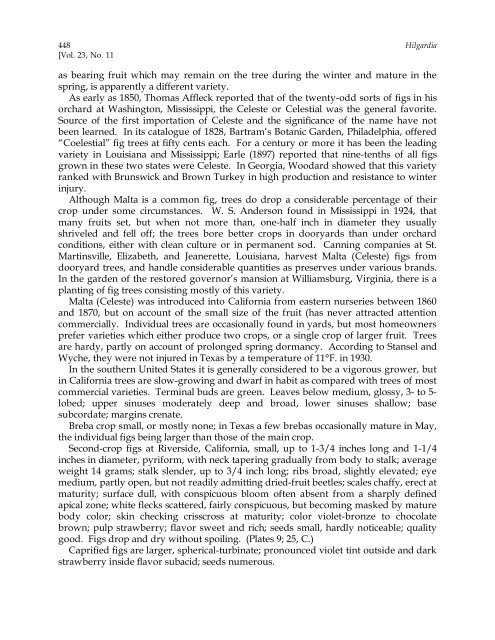Fig Varieties: A Monograph - uri=ucce.ucdavis
Fig Varieties: A Monograph - uri=ucce.ucdavis
Fig Varieties: A Monograph - uri=ucce.ucdavis
You also want an ePaper? Increase the reach of your titles
YUMPU automatically turns print PDFs into web optimized ePapers that Google loves.
448 Hilgardia<br />
[Vol. 23, No. 11<br />
as bearing fruit which may remain on the tree during the winter and mature in the<br />
spring, is apparently a different variety.<br />
As early as 1850, Thomas Affleck reported that of the twenty-odd sorts of figs in his<br />
orchard at Washington, Mississippi, the Celeste or Celestial was the general favorite.<br />
Source of the first importation of Celeste and the significance of the name have not<br />
been learned. In its catalogue of 1828, Bartram’s Botanic Garden, Philadelphia, offered<br />
“Coelestial” fig trees at fifty cents each. For a century or more it has been the leading<br />
variety in Louisiana and Mississippi; Earle (1897) reported that nine-tenths of all figs<br />
grown in these two states were Celeste. In Georgia, Woodard showed that this variety<br />
ranked with Brunswick and Brown Turkey in high production and resistance to winter<br />
injury.<br />
Although Malta is a common fig, trees do drop a considerable percentage of their<br />
crop under some circumstances. W. S. Anderson found in Mississippi in 1924, that<br />
many fruits set, but when not more than, one-half inch in diameter they usually<br />
shriveled and fell off; the trees bore better crops in dooryards than under orchard<br />
conditions, either with clean culture or in permanent sod. Canning companies at St.<br />
Martinsville, Elizabeth, and Jeanerette, Louisiana, harvest Malta (Celeste) figs from<br />
dooryard trees, and handle considerable quantities as preserves under various brands.<br />
In the garden of the restored governor’s mansion at Williamsburg, Virginia, there is a<br />
planting of fig trees consisting mostly of this variety.<br />
Malta (Celeste) was introduced into California from eastern nurseries between 1860<br />
and 1870, but on account of the small size of the fruit (has never attracted attention<br />
commercially. Individual trees are occasionally found in yards, but most homeowners<br />
prefer varieties which either produce two crops, or a single crop of larger fruit. Trees<br />
are hardy, partly on account of prolonged spring dormancy. According to Stansel and<br />
Wyche, they were not injured in Texas by a temperature of 11°F. in 1930.<br />
In the southern United States it is generally considered to be a vigorous grower, but<br />
in California trees are slow-growing and dwarf in habit as compared with trees of most<br />
commercial varieties. Terminal buds are green. Leaves below medium, glossy, 3- to 5-<br />
lobed; upper sinuses moderately deep and broad, lower sinuses shallow; base<br />
subcordate; margins crenate.<br />
Breba crop small, or mostly none; in Texas a few brebas occasionally mature in May,<br />
the individual figs being larger than those of the main crop.<br />
Second-crop figs at Riverside, California, small, up to 1-3/4 inches long and 1-1/4<br />
inches in diameter, pyriform, with neck tapering gradually from body to stalk; average<br />
weight 14 grams; stalk slender, up to 3/4 inch long; ribs broad, slightly elevated; eye<br />
medium, partly open, but not readily admitting dried-fruit beetles; scales chaffy, erect at<br />
maturity; surface dull, with conspicuous bloom often absent from a sharply defined<br />
apical zone; white flecks scattered, fairly conspicuous, but becoming masked by mature<br />
body color; skin checking crisscross at maturity; color violet-bronze to chocolate<br />
brown; pulp strawberry; flavor sweet and rich; seeds small, hardly noticeable; quality<br />
good. <strong>Fig</strong>s drop and dry without spoiling. (Plates 9; 25, C.)<br />
Caprified figs are larger, spherical-turbinate; pronounced violet tint outside and dark<br />
strawberry inside flavor subacid; seeds numerous.
















![Fig Trees in North Carolina [Archive] - IDigMyGarden ... - Figs 4 Fun](https://img.yumpu.com/26905320/1/190x245/fig-trees-in-north-carolina-archive-idigmygarden-figs-4-fun.jpg?quality=85)